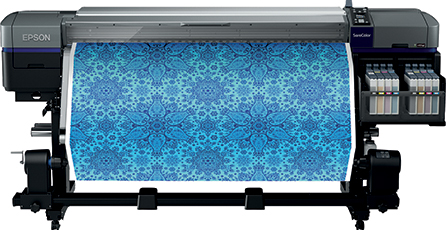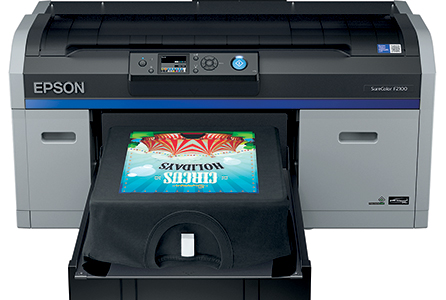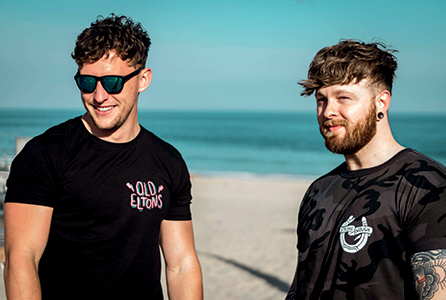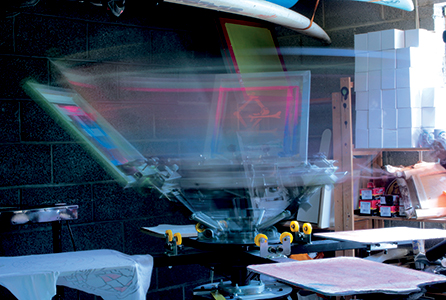
Fabric printing is believed to date back to the fourth century BC
Living in a material world
The art of fabric printing is believed to date back as far as the fourth century BC, with countries such as China and India first adopting the technique of wood block printing. Screen- printing followed, spreading across much of Asia and later, Europe.
It was during the industrial revolution in the 1760s that saw the process become much more mechanised with the birth of cylinder printing.
Dye-sublimation came into play in 1957 and is the process of transferring dye onto materials such as plastic, paper or fabric using heat. Following shortly after in the 1990s and digital printing developed to become an efficient and cost effective way to achieve short print runs with the necessary element of flexibility.
Fast-forward 30 years and inkjet printing of textiles remains one of the fastest growing segments within the digital print ecosystem with the worldwide market rising to €2.83bn in 2018 – more than double its value in 2013.
O Factoid: The digitally printed textiles market is predicted by Smithers Pira to grow to €4.9bn (£4.22bn) in 2023 O
Looking forward and the digitally printed textiles market is predicted by Smithers Pira to grow to €4.9bn (£4.22bn) in 2023. So, what are the most realistic textile print services you can add to your business?
Not for the faint hearted
Having invested heavily in textile print, Scott Conway, director of Venture Banners, describes the growing market as not for the faint hearted or those without deep pockets. The company now has two FabriVu 3.2m machines which it uses for stretch materials, display polyester and backlit fabrics alongside a Klieverik calendar unit to provide fixation.
The firm also has an Mtex 3.2HS with inline fixation which it uses to print its flags, and a 3.2m-wide Zünd digital cutter with a textile cutting module. Due to the need for controlled humidity to eliminate static and ensure high print quality, Venture Banners also has a fully humidified production floor at its Essex-based facility. This paints a picture of the various elements required to add textiles to your offering.
Conway says: “The best way to include textiles into your current range of services and enter this lucrative market is to offer finished textile products such as stretch frames and silicone edged graphics (SEG) frames.”

Offer finished textile products such as stretch frames and silicone edged graphics (SEG) frames”
According to Conway, these types of frames, both backlit and frontlit are becoming more widely used in retail environments and once installed, generate an additional revenue stream in replacement graphics. They are also easy to install which saves time and money and makes consumers more likely to opt for this form of point-of-sale in the future.
Conway adds: “The benefits of textiles are numerous, apart from the fact they look richer and more vibrant than traditional PVC-based graphics they are easy to install and logistically are easier to dispatch and can be delivered in a jiffy bag rather than large rolls that can be damaged in transit.”
Ready and waiting
Epson offers a range of textile printing technologies, from dye-sublimation technology ranging from entry-level SC-F6300 to its production-level SC-F9300 printers. For direct-to-garment it offers the SC-F2100 on which users can print directly onto cotton-based items such as t-shirts and bags. For direct-to-fabric, Epson offers an industrial digital textile printing solution. The Monna Lisa series is driven by Epson PrecisionCore printhead technology and using this, customers are able to use acid, reactive, disperse or pigment inks to print onto a diverse range of fabrics.

Epson’s production-level SC-F9300
With technologies such as this ready and waiting to be utilised, Tom Owers, product manager for Epson Europe recommends looking to add services such as soft signage including trade show graphics, retail décor, textile banners, mesh and flag materials. He says: “Fabric printing is eco-friendly, and the materials are lightweight and flexible, reduce shipping, installation and labour costs. Tension fabric display systems are now available so sewing and finishing is straighter forward than ever.”
Owers also recommends bespoke and short-run textiles and garments for manufacturers and designers such as fashion, sportswear and home décor, as well as retail such as curtains, cushions, chairs and bedding. T-shirt printing can also be completed using the SC-F2100 which offers low start-up costs, minimal resource and high margin product.

Users can print directly onto cotton-based items such as t-shirts and bags using the F2100
“In addition to the above, customers can also use dye-sublimation printers to produce bespoke rigid substrates and promotional goods such as mugs, coasters, phone cases, and bottles. Moving to dye-sublimation is not a huge technology change for a customer who does signage today, but provides them with the ability to take on different jobs for their existing customers and attract new customers, maybe to bring out-sourced businesses in-house and give greater control over quality, turnaround times, cost and profitability.”
Phil McMullin, UK sales manager for Pro Graphics at Epson adds: “There is a large range of textiles available for these ink sets which can produce acceptable finished results but generally there tends to be a compromise involved.
“So, if you want to maintain the vibrancy and colour gamut of your original design and ensure the inks chemically bind with your materials then the only real option is dye-sublimation.”
A high-volume solution
Recognising textiles as a growing market, HP decided to “reinvent” dye-sublimation. Michael Lewis, large-format account manager, explains: “By listening to the print providers and their problems regarding the complexity of printing on textile, HP developed its new range of Stitch products to address these issues, making printing on textiles easier.
“This has been achieved by combining HP’s existing thermal printhead technology with new dye-sublimation inks – while also adding additional features, such as automatic maintenance and nozzle compensation, as well as drop and dry print zone dryer.”
HP offers three textile printing models. The HP Stitch S300, 64” entrance model is designed for easy operation. The HP Stitch S500, 64” production model is designed for increasing productivity and efficiency. And the HP Stitch S1000, 126” production model is designed for robust and continuous production.
All printers in this portfolio combine HP thermal inkjet technology with industry-standard dyes for strong colour durability. Lewis comments: “Our first-ever built-in spectrophotometer (colour calibration device) enables Stitch’s fast and exact colour-matching, allowing users to print on multiple Stitch models at the same time in the comfort of knowing the colour will be the same.
“The range-topping HP Stitch S1000 is positioned for industrial print-service-providers who need high-volume production – ideal to meet short deadlines and seasonal peaks of production with high productivity modes. The S1000 reaches a maximum production speed of up to 220sq m/h and backlit speed up to 130sq m/h.”
Much like Conway, Lewis lists frontlit and backlit prints within retail point-of-sale and exhibition markets as the most realistic service for those new to the market and looking to shift away from the standard signage substrate. This is due to the fact that fabric materials are more easily and cheaply transported and can be finished at a higher standard.
Do it yourself
And if this range of entry-level, yet, state-of-the-art technology still has you feeling like entering this growth market is a daunting, expensive and impossible feat. Jack Merrony, owner of Old Eltons is just one example of how anyone can set up a textile service.

Jack Merrony, owner of Old Eltons, has now added another t-shirt design business to his offering
In 2016, Merrony began his embroidery and print business using a starter kit in his parent’s garage. After months of trial and error and some support from others in the industry, Merrony now offers screen- printing, embroidery, heat transfer vinyl and logo design and has already outgrown two sites.
Describing his experience of starting out from scratch, Merrony says: “The business came about as my parents own two surf shops locally and thought it was a good idea to start stocking something local, as well as buying in big name brands. My parents and I were sat around the kitchen and we discussed this idea of having a print shop in the garage so we started looking into buying a starter kit.
“I had absolutely no experience in this particular industry and it’s not even funny as to how daunted I was when this pallet arrived at my parent’s house. The carousel came with no instructions and when I finally finished building it, it wasn’t the same press that I had bought online. My dad helped me out as it was such an awkward bit of machinery. Then came months of learning how to screen.”

Screen printing is a simple and low-cost way to enter the market
Merrony describes this process as one of the biggest mental hurdles he has had to endure, but he called on nearby businesses Dave Roper and Pyramid Printing to see if they had any suggestions.
He continues: “A month went by and still no luck, so I decided to reach out to The Printhaus in Cardiff. They were happy with me bringing my whole exposure unit up to them where we ran loads of tests. It turns out that the bulbs that were sent with the machine weren’t intense enough in order to burn the screen correctly.
“Once I changed these out, I did it. I burnt my first screen and man, it was such a good feeling. I was going to give up the week before and I am so glad I pushed on. Massive thank you to Tom, Shaun and Jude of The Printhaus for helping me get over this part in my career.”
Since dipping his toes into the water of textile printing, Merrony says he struggles to comprehend just how fast business has grown. In the last year, he has created his own brand on the side of the studio called Old Eltons Clothing and is looking to move into another space locally to expand to another manual press and more embroidery machines to speed up production.
So, with all the technology and information available, it has never been easier to add textile printing to your business.
Your text here...